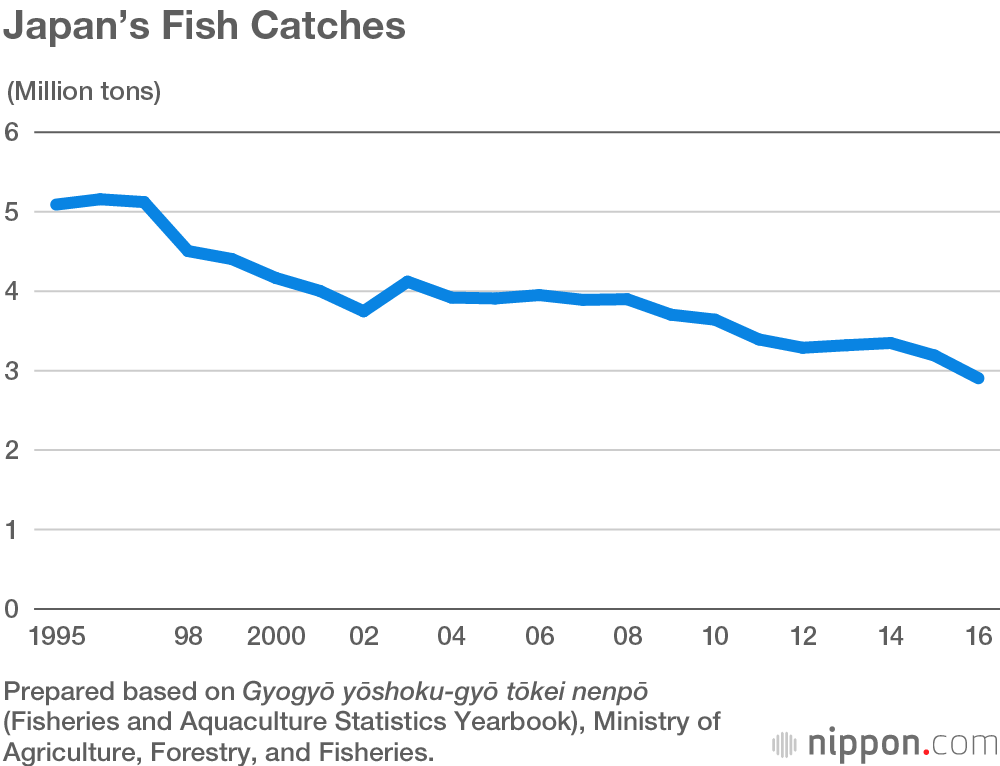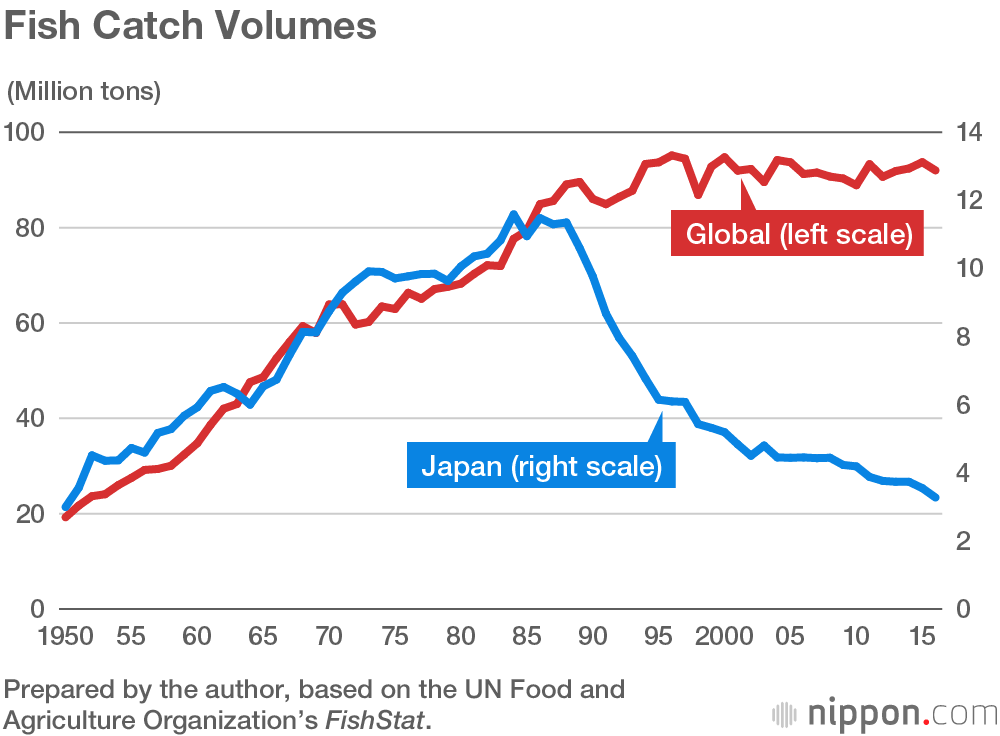Overfishing entails the overwhelming imbalance between fish removal from water bodies and the replenishing rate of such species. The ultimate impact of this activity is the underpopulation of fish within the affected areas, such as ponds, lakes, or even oceans. Japan is a critical fishery hub and contributes immensely to global fish exports. Therefore, the management of its fishery breeds is crucial to the country and the world’s economy. The excessive harvesting of certain species in the country’s vast marine life may result in an equilibrium shift and overbreeding of other sea creatures, making it difficult for the overfished species to resuscitate. This report will present the economic issue surrounding overfishing in Japan and recommend practicable solutions and interventions.
Overfishing Issue in Japan
Five decades ago, Japan ranked first in the most competitive fishing industries globally. In the 1990s, the country’s catch volume began declining drastically, following the drop in the sardine populace (Toshio). This species contributed significantly to the total marine harvests in the country. One of the reasons given for the fall of sardines is the egg survival rate is lack of necessary countermeasures and stakeholder intervention (Toshio). Although natural causes mainly were attributed to the decline in the species, the government and partners in the fishing industry ignored the decline and failed to take necessary interventions. Figure 1 illustrates Japan’s marine harvesting trend in the past two decades.

Recently, the country’s catch volume has worsened due, in part, to the expansive aquaculture activities in the country. In 2019, the country’s fishery output dropped 4.2 tons from 2018’s 4.4 tons (Engelmann). Technological advances have enabled large-scale fishing in lakes, seas, and other water bodies. The downward trend in fish catch has been more popular in marine fisheries, with increased harvesting of seafood species and popular fish like tuna, crabs, and mackerels. The decline in fish catch has also resulted in a drop in the revenue generated from fishing. Table 1 below indicates a decade’s production volume of fish in Japan.
The 10-year trend indicates a gradual decline in fish volume, associated with a lack of effective measures to resuscitate fish beading regions. According to Toshio, the recovery of Japan’s fishing grounds depends on the regulation of catches. Notably, Japan’s catch volumes have exhibited an anomaly drift compared to the global catches. Thus, the problem of overfishing is more severe in the country, requiring immediate action. Figure 2 compares Japan and the global catch volumes from 1950 to 2015.

Recommended Solutions
Imposing Quotas
This measure entails setting limits to catches based on designated vessel capacity. Toshio argues that imping quotas should also involve restraining operators from stiff completion, which leads to the harvesting of younger fish. This initiative will help boost catches’ value and create a healthy business environment. The government should individualize quotas based on bulk to balance breeding grounds. Quotas also include designating certain seasons in which fishing is prohibited to recover deteriorating species (Toshio). Authorities should also restrict the size of fish allowed to be caught by companies and individual fisherpersons.
Conservation of Endangered Species
Japanese seas have harbored multiple endemic species that cannot be found elsewhere globally. Companies are overzealous about fishing these species because of their high market demand and rarity. Such fish need protection against fishing to survive and repopulate. In the documentary Seaspiracy, Ali Tabrizi argues that commercial fisheries are the chief contributors of overfishing in most regions. Unlike quotas, the conservation of endangered species entails the proactive restrain of activities that would result in the fishing of certain types of marine life. The cooperation between the government and these organizations is vital in ensuring sustainable fishing.
Tougher Illegal Fishing Laws
Enacting stricter laws is aimed to enforce conservation measures against the harvesting of endemic species. Toshio contends that the newly revised Fisheries Act has redefined the measures to combat overfishing in the region. Further, the law has been critical in eliminating any ambiguities in restricting domestic and international fishing undertakings. The Act also expanded fish quotas from eight species to more than 15, promoting the growth of the fishing industry (Toshio). More such laws are needed to illegalize harmful activities that can have been causing catastrophic fishing declines, as is the case with fishing quotas. Major fishing companies have displayed their conservation spirit as mere cover-ups, depicting corruption in the industry (“Seaspiracy”). Thus, the government should impose restrictions to ensure that companies follow these rules.
Protecting Marine Areas
Safeguarding marine areas requires a legal framework like the one established by the aforementioned Fisheries Act. Unrestricted fishing has caused the degradation of fishing observed in the past decades in the country. Principally, the potential impact of preserving aquatic life is allowing the recovery of species, thus securing fishing for future generations. While some natural activities are associated with the decline in fish breeding, the fall has also resulted from human activities (“Seaspiracy”). Water pollution through plastic debris and ghost nets have heightened the impact of overfishing in Japan. Therefore, protecting marine regions will help minimize contamination and save thousands of precious marine species.
Conclusion
Fishing in Japan is a critical economic activity contributing to national and international food security. The long-ignored deteriorating fishing grounds have challenged the sustainability of the industry. Overfishing has increased the number of endangered species while causing a decline in fishing catches. There is a need for government interventions to restrict harmful activities and promote the growth of the industry. Recommended initiatives include imposing quotas, protecting endangered species, imposing stricter laws, and safeguarding marine areas. These measures can help Japan reclaim its place among the top fishing industries globally.
Works Cited
Engelmann, Julia. “Fishing industry production volume in Japan 2010-2019.” Statista. Web.
Seaspiracy. Directed by Ali Tabrizi, performed by Sylvia Earlie, Paul Watson, and Ric O’Barry. A. U. M. Films. 2021. Netflix.
Toshio, Katsukawa. “Building a Future for Japan’s Fisheries Industry.” Nippon. 2019. Web.
